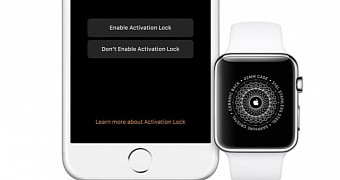With all the technology they integrate, smartwatches are no match for the street version of Apollo Robbins and the likes, but Apple plans to change this for its product through the introduction of a new security feature.
It is called the Activation Lock and will be integrated in the second version of the watchOS, scheduled for release this fall. The security feature is also available on iPhones.
Even without it, Apple Watch comes protected against threats, as a set of sensors on its back can detect when it is worn by an individual and lock it automatically when removed from the wrist. Getting past the lock screen requires the user to enter a code, previously set for this purpose.
Thieves will end up with a useless device
However, Activation Lock has reportedly contributed to a decrease in smartphone thefts since its introduction on iPhone.
According to online sources, the number of such incidents has spiraled down, London City Hall reporting in June 2014 a drop of 24% since the feature became available in September 2013.
This effect was also accounted by the fact that people looking to buy an iPhone would avoid a device that was locked since this was an indication that it was stolen.
Activation Lock ensures that the iDevice cannot be activated without the iCloud Apple ID and password, keeping all information on it safe from unauthorized people, if it is stolen.
More than this, the security feature prevents the device from being reset to factory defaults, making it worthless to the thief since it cannot be paired with a new iPhone.
The importance of Apple Watch will grow
Except for the security code that unlocks the device, the current version of watchOS does not include protection against a reset, and the effort to do it is minimum, as shown in multiple videos online.
Apple Watch is not just a device that connects to the iPhone and offers a simple way to check notifications; it is also designed to improve payments to merchants via contactless transactions.
On the same note, with the next version of the operating system on board, the gadget will be suitable for using rewards from retailers as well as credit and debit cards issued by various merchants. As such, a third party with access to it will also have access to the payment instruments of the owner.

 14 DAY TRIAL //
14 DAY TRIAL //